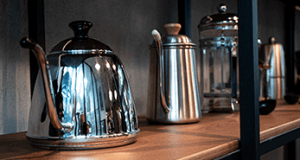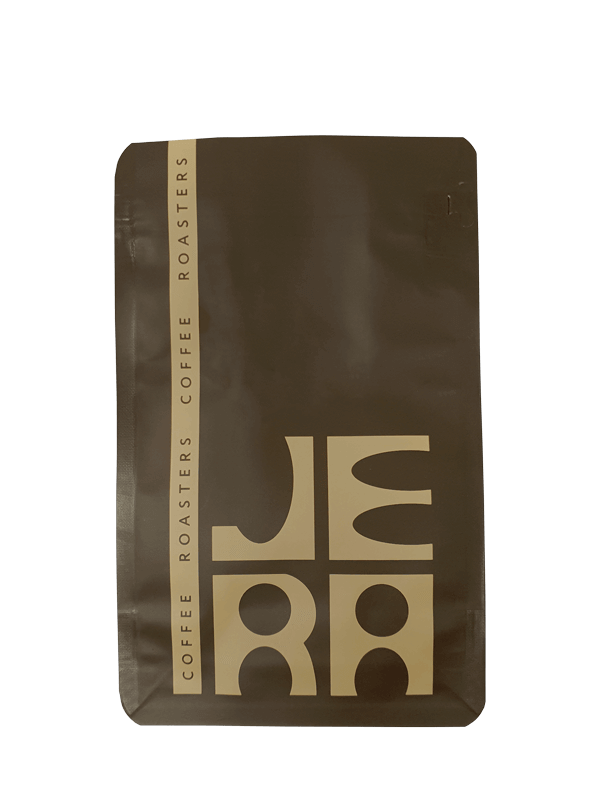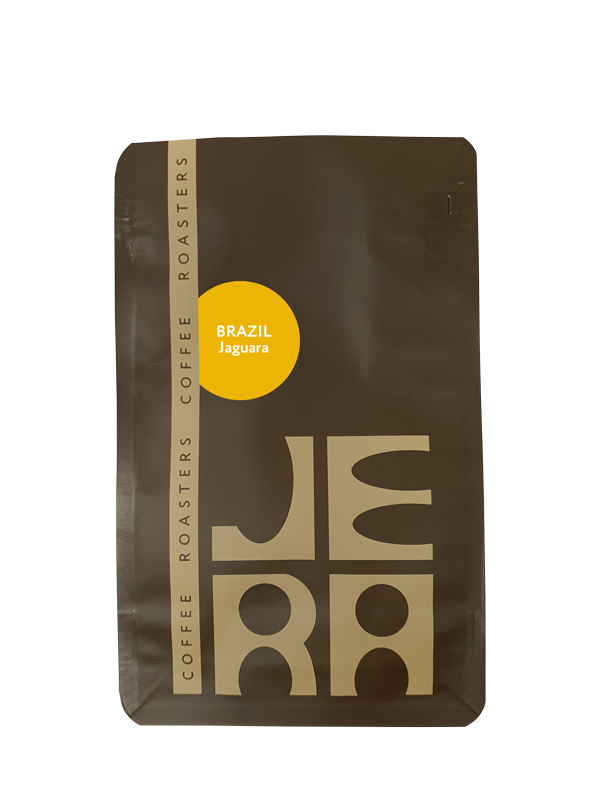קפה קלוי קולומביה | Huila, Villa Pastora
קפה קולומביאני עם ארומה של קוקוס
אחד הקפה המיוחדים שהיו לנו אי פעם. מאוד מתוק, מורכב ומיוחד. גוף עגול ומאוזן, מרירות נמוכה, חמיצות מאוזנת ועסיסית, מתיקות גבוהה וארומות מטורפות של פירות טרופיים וקוקוס. מצוין להכנת כל סוגי קפה פילטר!
₪60.00 – ₪400.00
ברכישת כל סוגי קפה קלוי בסכום:
בין 600 ש"ח ל-1000 ש"ח עם קוד קופון "15%" תקבלו 15% הנחה
בין 1001 ש"ח ל-1500 ש"ח עם קוד קופון "25%" תקבלו 25% הנחה
מעל 1501 ש"ח עם קוד קופון "30%" תקבלו 30% הנחה
Colombia Villa Pastora
גרסון מורה הוא מגדל קפה קטן מחוז הוילה. החווה שלו, וילה פסטורה, נקראת על שם סבתו, פסטורה, שניהלה את החווה משנות ה-80 ועד 2002. מדובר בחוות קפה משפחתית, שבה עובדים בני הדור השני והשלישי, ששותפים לפעילות היומיומית. בחווה מגדלים זני בורבון ורוד, בורבון כתום ובורבון מפוספס. במשך שנים הם מתמקדים בייצור קפה איכותי ובעל אופי ייחודי, ושואפים שיכירו בהם בזכות כך.
בורבון אדום
בורבון הוא אחד מזני הקפה החשובים ביותר בתעשייה. בדומה לטיפיקה, הוא מהווה אב להרבה זני ערביקה אחרים. כיום, בורבון משמש בעיקר כחומר גנטי לפיתוח זנים חדשים ומבטיחים — אחד מהם הוא הבורבון האדום.
בורבון אדום הוא מוטציה טבעית של ערביקה, שהופיעה לראשונה באי בורבון בתחילת המאה ה-18. הזן הזה משגשג באזורי גידול גבוהים עם אקלים מתון, בדרך כלל בגבהים של 1,200–2,000 מטר מעל פני הים. הוא מעדיף אדמה וולקנית ודורש הקפדה על קטיף בזמן הנכון, משום שאיכות הפולים תלויה מאוד בקטיף מדויק ובשל.
קפה מקולומביה
קולומביה היא מדינה הררית, עם גבהים שמגיעים עד 2,200 מטר מעל פני הים. הקפה גדל במדרונות תלולים, ולכן יש לקטוף אותו כולו ביד. המדינה נמצאת ישירות על קו המשווה, ובשילוב עם טווח הגבהים הרחב שבה, ניתן לקצור קפה כמעט כל השנה. רוב הקפה הקולומביאני מגודל בחוות קטנות שבבעלות חקלאים עצמאיים — גודל ממוצע של חווה הוא רק 3 דונם. רבות מהחוות ממוקמות ביערות הרריים, שם הקפה גדל בצל עצים, והגישה אליהן יכולה להיות קשה מאוד. לעיתים קרובות אי אפשר להגיע אליהן ברכב, ולכן חקלאים רבים משתמשים בסוסים או חמורים — שיכולים לעבור במקומות שרכב אינו מסוגל.
האקלים הלח והטמפרטורות הנמוכות בגבהים הגבוהים גורמים לכך שעיבוד רטוב (washed) הוא השיטה הנפוצה ביותר לעיבוד קפה בקולומביה.
קולומביה היא יצרנית הקפה השלישית בגודלה בעולם. חוות הקפה במדינה ממוקמות באזורים הרריים, בטווח גבהים של בין 1,000 ל-2,300 מטר מעל פני הים. בזכות טווח הגבהים הרחב הזה, קולומביה מציעה מגוון רחב של פרופילים לקפה — מקפה קליל ופרחוני ועד קפה עשיר ושוקולד.
קפה בעיבוד טבעי עם קו-פרמנטציה אנאירובית בקוקוס
עיבוד טבעי אנאירובי עם הלם תרמי וקו-פרמנטציה בקוקוס ושמרים.
הדובדבנים הבשלים נבחרים בקפידה ביד, וכל הדובדבנים שאינם בשלים או שאינם מפותחים מוסרים בשלב ציפה ראשוני.
לאחר מכן מוכנסים הדובדבנים הנבחרים למכלי פלסטיק לתהליך תסיסה אנאירובית. בשלב זה מוסיפים מוסטו קוקוס (נוזל קוקוס מותסס) בשילוב עם שמרים. התסיסה הראשונית נמשכת בין 60 ל-72 שעות, בהתאם לטמפרטורה הסביבתית.
לאחר סיום התסיסה הראשונית, התהליך עובר לשלב שני: חמצון. בשלב זה פותחים את המכלים והדובדבנים נשארים חשופים לאוויר למשך 36 עד 48 שעות. חשיפה זו לחמצן מאפשרת למסת התסיסה להתחמצן ומעלה את הטמפרטורה שלה לכ-40 מעלות צלזיוס. כאשר הדובדבנים מסיימים את שלב החמצון ומגיעים לטמפרטורה הרצויה, הם עוברים טיפול בהלם תרמי באמצעות השריה במים קרים בטמפרטורה של 16 מעלות צלזיוס. בסיום, הדובדבנים נשארים במים הללו למשך כ-24 שעות נוספות.
מיקרולוט
מיקרולוט הוא אצווה של קפה מעונה מסוימת, שקיבלה ציון גבוה בקאפינג ואפשר לעקוב אחרי מקורו. אנחנו יודעים באיזה אזור הוא גדל, איזה חקלאי גידל אותו, איך הוא נקטף ואיך הוא עובד. המידע הזה כשלעצמו לא משפיע ישירות על הטעם. עם זאת, כאשר חקלאי מוכר קפה ישירות, זה בדרך כלל אומר שהקפה גודל, נקטף ועובד בצורה הרבה יותר מוקפדת — מה שבדרך כלל מביא לטעם טוב יותר. גידול של קפה יוצא דופן דורש תשומת לב רבה בכל שלב: מתנאי הגידול ובחירה של דובדבנים בשלים בלבד, ועד בקרה קפדנית על תהליך העיבוד. כדי לגדל קפה כזה, חקלאים משקיעים הרבה מאמץ וכסף. באותו הזמן, הם לוקחים סיכונים משמעותיים — אפילו תקופה קצרה של תנאים לא מתאימים יכולה להרוס את כל מאמציהם. הקפה אולי ייצא טוב, אבל כבר לא יהיה ייחודי, והחקלאי עלול להפסיד כלכלית. מיקרולוטים בדרך כלל יקרים יותר מקפה רגיל משתי סיבות: ראשית, לקפה כזה ניתנת תשומת לב רבה בכל שלב של הייצור. החקלאים חייבים לטפל בגידול בקפידה, לקטוף אותו בדיוק ולעבד אותו בנפרד מהשאר. זה מעלה את עלויות הייצור — ולכן גם את המחיר הסופי. שנית, כתוצאה מהשקעה בפרטים הקטנים, הטעם של קפה כזה יוצא לרוב בהיר ונקי יותר באופן משמעותי. בהרבה חוות מוכרות, הקונים מזמינים מיקרולוטים שנים מראש. בשל הביקוש הגבוה, החקלאים מעלים את המחירים.
פייר טרייד (Fair Trade)
מטרת הסמכה זו היא לתמוך בתנאי עבודה ושכר הוגנים בחוות במדינות מתפתחות. באופן מסוים, היא מקדמת סחר הוגן, ולא מתייחסת רק לקפה אלא גם למוצרים נוספים. ההסמכה פופולרית במיוחד בקרב צרכנים במדינות מפותחות שבהן קיימת מודעות גבוהה יותר לצריכה מוסרית – בעיקר בארצות הברית ובצפון אירופה.
הסמכת Fair Trade מבטיחה שלא נעשה שימוש בעבודת ילדים בחוות, שעובדים מקבלים שכר הוגן, ושמתקיימים תקני בריאות ובטיחות בעבודה. הארגון מבצע בדיקות שוטפות בחוות המאושרות כדי לוודא שהן עומדות בדרישות.
Colombia Villa Pastora
Gerson Mora is a small-scale coffee farmer based in Huila. His farm, Villa Pastora, was named in honor of his grandmother, Pastora, who oversaw its operations from the 1980s until 2002. Villa Pastora remains a family enterprise, with second- and third-generation coffee growers actively involved in day-to-day work. On the farm, they cultivate pink bourbon, orange bourbon, and striped bourbon varieties. For many years, their mission has been to produce distinctive, high-quality coffees and gain recognition for their efforts.
Red Bourbon
Bourbon is one of the most important coffee varieties in the industry. Like Typica, it is a parent to many Arabica cultivars. Today, Bourbon is primarily used as genetic material for breeding new, promising varieties – one of which is Red Bourbon. Red Bourbon is a natural Arabica mutation that first appeared on the island of Bourbon in the early 1700s. This variety flourishes in regions of high elevation with moderate climates, generally ranging from 1,200 to 2,000 meters above sea level. It does best in volcanic soils and demands meticulous harvesting practices, as the bean quality is highly dependent on picking the cherries at peak ripeness.
Coffee from Columbia
Colombia is a mountainous country, with elevations reaching up to 2,200 meters. Coffee grows on steep hillsides, so it must be harvested entirely by hand. The country lies directly on the equator, and combined with its broad altitude range, this allows for nearly year-round harvesting. Most Colombian coffee is grown on small farms owned by independent farmers — the average farm size is only 3 hectares. Many of them are located in mountain forests, where coffee grows in the shade of trees, and accessing these farms can be extremely difficult. Often, it's impossible to reach them by car, so horses or donkeys are commonly used by farmers – they can pass where vehicles cannot.
The country’s humid climate and low temperatures at high altitudes make washed processing the most common method for Colombian coffee.
Colombia is the third largest coffee producer in the world
Coffee farms in the country are located in mountainous regions, ranging from 1,000 to 2,300 meters above sea level. Due to this wide altitude range, Colombia offers a great diversity of coffee profiles—from light and floral to rich and chocolatey.
Natural Anaerobic Coconut Co-Fermentation Process Coffee
Natural Anaerobic Thermal Shock Coconut and Yeast Co-Fermentation Process.
Ripe cherries are carefully hand-selected, and any unripe or undeveloped cherries are removed during an initial flotation step. The chosen cherries are then placed into plastic tanks to undergo anaerobic fermentation. During this stage, a coconut mosto (a fermented coconut liquid) combined with yeast is added. This first fermentation lasts between 60 and 72 hours, depending on the surrounding temperature. After completing the initial fermentation, the process enters a second phase: oxidation. Here, the tanks are opened and the cherries are left exposed to air for 36 to 48 hours. This oxygen exposure allows the mass to oxidize and raises its temperature to around 40°C. Once the cherries finish oxidizing and reach the target temperature, they undergo a thermal shock treatment by being immersed in cold water at 16°C. Finally, the cherries remain in this water for approximately another 24 hours.
Microlot
A microlot is a batch of coffee from a specific harvest season that has received a high cupping score and has traceable origins. We know which region it was grown in, which farmer cultivated it, how it was harvested, and how it was processed. This information alone doesn’t directly affect the taste. However, if a farmer sells coffee directly, it usually means the coffee is grown, harvested, and processed with much more care — which typically results in better flavor. Growing exceptional coffee requires close attention at every stage: from the growing conditions and the selection of only ripe cherries to careful control during processing. To grow such coffee, farmers invest a great deal of effort and money. At the same time, they take significant risks — even a brief period of unfavorable conditions can undo all their efforts. The coffee may still turn out good, but no longer unique, and the farmer may end up with financial losses. Microlots are usually more expensive than regular coffee for two reasons: First, this type of coffee is given more attention at every stage of production. Farmers must carefully tend to the crop, harvest it with precision, and process it separately from the rest of the coffee. This increases production costs — and therefore the final price. Second, as a result of this attention to detail, the flavor of such coffee is often significantly brighter and cleaner. On many well-known farms, buyers reserve microlots years in advance. Due to high demand, farmers raise prices.
Fair Trade
The goal of this certification is to support fair working conditions and wages on farms in developing countries. In a way, it advocates for fair trade and applies not only to coffee but also to other products. It is especially popular among consumers in developed countries with more conscious consumption habits — mainly in the U.S. and Northern Europe.
Fair Trade certification means that no child labor is used on the plantation, and workers receive fair wages while health and safety standards are maintained. The organization regularly inspects the conditions on certified farms to ensure compliance.












